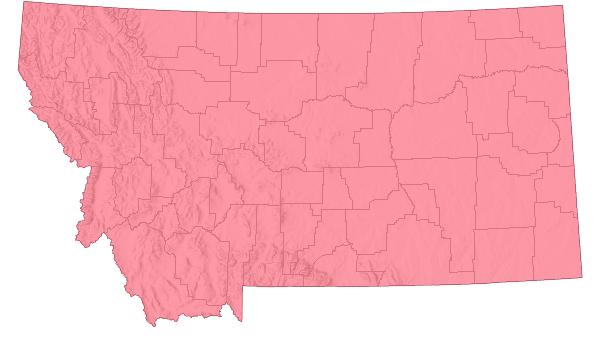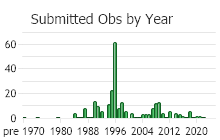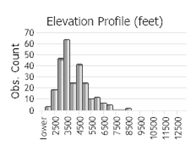View in other NatureServe Network Field Guides
NatureServe
Montana
Utah
Wyoming
Idaho
Wisconsin
British Columbia
South Carolina
Yukon
California
New York
Redtop - Agrostis gigantea
Other Names:
Giant Bentgrass, Black Bentgrass,
Agrostis alba, Agrostis stolonifera var major
General Description
Perennials from rhizomes up to 25 cm long; stems 20-120 cm, sometimes rooting at lower nodes. Ligules becoming longer towards apex (1-4.5 mm for lower nodes, to 7 mm long on upper nodes) dorsal surface sometimes scabrous. Leaf blades 4-10 cm long, 3-8 mm wide and flat. Panicles up to 25(-30) cm long but less than half the culm, up to 15 cm wide; branches scabrous, spreading during flowering, usually with some branches bearing spikelets to their base. Glumes 1.7-3.2 mm, 1-veined, acute to apiculate, more or scabrous on the upper part of the midvein; callus hairs to 0.5 mm but sparse; lemmas 1.5-2.2 mm, 3-5 veined (veins usually obscure but sometimes prominent, especially distally) and sometimes excurrent to 0.2 mm, rarely with an awnof up to 1.5(-3) mm; paleas 0.7-1.4 mm long and about half the length of lemmas; anthers 3, 1-1.4 mm long. Caryopses 1-1.5 mm long (adapted from: Harvey, 2007, in Flora of N. America, Vol. 24).
Lavin and Seibert (2011, Grasses of Montana) include this species in synonymy of Agrostis stolonifera, based on the weakness of morphological characters in our area to convincingly differentiate them. Harvey (op. cit.) indicates that A. gigantea can be separated by having rhizomes and a more open panicle than A. stolonifera
Species Range
Montana Range
Range Descriptions

 Non-native
Non-native
Range Comments
Widespread across North America although far less common from ND to TX and east through GA and FL (Kartesz in prep. 2012).
Observations in Montana Natural Heritage Program Database
Number of Observations: 300
(Click on the following maps and charts to see full sized version)
Map Help and Descriptions
Relative Density

Recency



 (Observations spanning multiple months or years are excluded from time charts)
(Observations spanning multiple months or years are excluded from time charts)
Habitat
Fields, roadsides, ditches, and other disturbed habitats, mostly at lower elevations (Harvey, 2007: Flora of N. America, Vol. 24).
Management
Stewardship Responsibility
References
- Additional ReferencesLegend:
 View Online Publication
View Online Publication
Do you know of a citation we're missing? Boggs, K. W. 1984. Succession in riparian communities of the lower Yellowstone River, Montana. M.S. Thesis. Montana State University, Bozeman, 107 pp.
Boggs, K. W. 1984. Succession in riparian communities of the lower Yellowstone River, Montana. M.S. Thesis. Montana State University, Bozeman, 107 pp. Cope, M.G. 1992. Distribution, habitat selection and survival of transplanted Columbian Sharp-tailed Grouse (Tympanuchus phasianellus columbianus) in the Tobacco Valley, Montana. M.Sc. Thesis. Bozeman, Montana: Montana State University. 60 p.
Cope, M.G. 1992. Distribution, habitat selection and survival of transplanted Columbian Sharp-tailed Grouse (Tympanuchus phasianellus columbianus) in the Tobacco Valley, Montana. M.Sc. Thesis. Bozeman, Montana: Montana State University. 60 p. Hodgson, J.R. 1970. Ecological distribution of Microtus montanus and Microtus pennsylvanicus in an area of geographic sympatry in southwestern Montana. Ph.D. Dissertation. Bozeman, Montana: Montana State University. 65 p.
Hodgson, J.R. 1970. Ecological distribution of Microtus montanus and Microtus pennsylvanicus in an area of geographic sympatry in southwestern Montana. Ph.D. Dissertation. Bozeman, Montana: Montana State University. 65 p. Johnson, T. W. 1982. An analysis of pack and saddle stock grazing areas in the Bob Marshall Wilderness. M.Sc.Thesis. Bozeman, MT: Montana State University. 105 p.
Johnson, T. W. 1982. An analysis of pack and saddle stock grazing areas in the Bob Marshall Wilderness. M.Sc.Thesis. Bozeman, MT: Montana State University. 105 p. Lesica, P., M.T. Lavin, and P.F. Stickney. 2012. Manual of Montana Vascular Plants. Fort Worth, TX: BRIT Press. viii + 771 p.
Lesica, P., M.T. Lavin, and P.F. Stickney. 2012. Manual of Montana Vascular Plants. Fort Worth, TX: BRIT Press. viii + 771 p. Lesica, P., M.T. Lavin, and P.F. Stickney. 2022. Manual of Montana Vascular Plants, Second Edition. Fort Worth, TX: BRIT Press. viii + 779 p.
Lesica, P., M.T. Lavin, and P.F. Stickney. 2022. Manual of Montana Vascular Plants, Second Edition. Fort Worth, TX: BRIT Press. viii + 779 p. Martinka, R.R. 1970. Structural characteristics and ecological relationships of male blue grouse (Dendragapus obscurus (Say)) territories in southwestern Montana. Ph.D Dissertation. Bozeman, MT: Montana State University. 73 p.
Martinka, R.R. 1970. Structural characteristics and ecological relationships of male blue grouse (Dendragapus obscurus (Say)) territories in southwestern Montana. Ph.D Dissertation. Bozeman, MT: Montana State University. 73 p. Tuinstra, K. E. 1967. Vegetation of the floodplains and first terraces of Rock Creek near Red Lodge, Montana. Ph.D dissertation. Montana State University, Bozeman 110 pp.
Tuinstra, K. E. 1967. Vegetation of the floodplains and first terraces of Rock Creek near Red Lodge, Montana. Ph.D dissertation. Montana State University, Bozeman 110 pp. Zapatka, T.P. 1963. Some results of two limited hunting seasons on hen Pheasants in north central Montana. M.Sc. Thesis. Bozeman, Montana: Montana State University. 26 p.
Zapatka, T.P. 1963. Some results of two limited hunting seasons on hen Pheasants in north central Montana. M.Sc. Thesis. Bozeman, Montana: Montana State University. 26 p.
- Web Search Engines for Articles on "Redtop"





